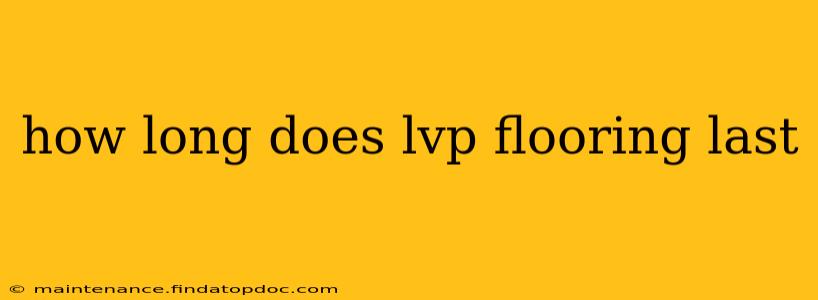Luxury vinyl plank (LVP) flooring has exploded in popularity due to its durability, water resistance, and stylish appearance. But how long can you expect your LVP floors to last? The answer isn't a simple number, as several factors influence its lifespan. This comprehensive guide will explore the longevity of LVP flooring, addressing common questions and concerns.
What is the average lifespan of LVP flooring?
The average lifespan of LVP flooring is 15-20 years, although with proper care and maintenance, it can potentially last even longer. This longevity makes it a cost-effective and long-term flooring solution compared to some other options. However, this is an average; high-traffic areas might show wear sooner, while less-used rooms could maintain their pristine condition for much longer.
What factors affect the lifespan of LVP flooring?
Several factors contribute to the longevity of your LVP flooring. Understanding these factors allows for better maintenance and prolongs the life of your investment.
1. Quality of the LVP Flooring:
The quality of the LVP itself significantly impacts its lifespan. Higher-end LVP flooring, with thicker wear layers and more durable core materials, will generally outperform cheaper options. Look for a thicker wear layer (at least 20 mils) for increased resistance to scratches and dents. The core material also matters; a rigid core LVP is typically more durable than a composite core.
2. Installation Quality:
Proper installation is crucial for LVP longevity. Uneven subfloors can lead to premature wear and tear, causing planks to buckle or separate. A professional installation ensures the planks are laid correctly, minimizing the risk of future problems.
3. Level of Foot Traffic:
High-traffic areas, such as hallways and kitchens, will naturally experience more wear and tear than less-used rooms like guest bedrooms. Expect higher-traffic areas to show signs of wear sooner than others.
4. Type of Subfloor:
The condition of your subfloor plays a vital role. Ensure your subfloor is level, clean, and dry before installing LVP. Any imperfections can transfer to the LVP, leading to damage.
5. Maintenance and Cleaning:
Regular cleaning and maintenance are key to preserving the appearance and lifespan of your LVP flooring. Sweeping or vacuuming regularly removes dirt and grit that can scratch the surface. Use a damp mop with a mild cleaner specifically designed for LVP to avoid damaging the finish. Avoid harsh chemicals and abrasive cleaners.
How can I extend the life of my LVP flooring?
Taking proactive steps can significantly extend the lifespan of your LVP flooring:
- Use area rugs in high-traffic areas: This helps protect the flooring from scratches and wear in areas prone to heavy foot traffic.
- Use furniture pads: Placing furniture pads under heavy furniture prevents dents and scratches.
- Address spills promptly: Quickly clean up spills to prevent staining and damage.
- Regular maintenance: Follow the manufacturer's cleaning recommendations for your specific LVP flooring.
- Avoid dragging heavy objects: Lift and carry heavy items to avoid scratching the surface.
Does LVP flooring last longer than other flooring options?
Compared to some flooring options, LVP offers a relatively long lifespan. It generally outlasts laminate flooring but may not last as long as solid hardwood in optimal conditions. However, LVP's resilience to water damage and its affordability make it a competitive choice for many homeowners.
How do I know when it's time to replace my LVP flooring?
It's time to consider replacing your LVP flooring when:
- Extensive damage is evident: Significant scratches, dents, or gouges that cannot be repaired.
- Water damage has occurred: Severe water damage can compromise the integrity of the flooring.
- The flooring is beyond repair: If the damage is too extensive and repair is impractical or excessively costly.
By understanding the factors affecting LVP lifespan and implementing proper care, you can enjoy the beauty and durability of your LVP flooring for many years to come. Remember to always consult the manufacturer's instructions for specific maintenance and care guidelines for your particular LVP product.
